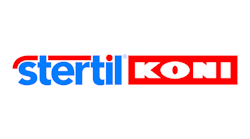Stertil-Koni Reports Heavy-Duty Lifting Goes Green with Benefits to Environment and Bottom Line
As municipalities, trucking companies and bus lines struggle to contain costs and improve margins, an increasing number are discovering the benefits of going green — an approach that can benefit the environment and the bottom line as well.
According to Dr. Jean DellAmore, president of Stertil-Koni, “For municipalities and fleet operators, the pressure to go green extends well beyond government mandates to also include end users who increasingly demand that products and services they consume reflect a more eco-centric approach.”
Topping the list for change is an obvious choice: reducing fuel costs. Small improvements in fuel economy translate into large savings. That’s why many transportation pros have embraced a range of tactics including re-designed vehicle aerodynamics, use of more fuel-efficient tires and the adoption of idle-reduction technologies. Noted DellAmore, “Collectively, these approaches alone can cut fuel consumption by approximately 20 percent.”
At the same time, some bus operators have taken energy efficiency to the next level by using ultra-low sulfur diesel (ULSD) or biodiesel and many have purchased cutting-edge, emissions-lowering technology to substantially reduce particulate emissions. Others have converted to propane — and captured attractive tax credits in the process. Another rising technology now available is a modified approach to the global positioning system (GPS), which permits municipalities and operators to reduce unnecessary idling as well as closely monitor road speed and braking patterns. The net result is that one major operator has already reported a 5 percent savings on tire wear and an 8 percent improvement in fuel economy.
Emphasis on Maintenance Facilities and Maintenance Equipment
DellAmore said, “Opportunities to go green and reduce transportation costs extend well beyond the vehicles to the very structures which house them and the equipment used to service them.” For example, many maintenance facilities now use low-mercury, high-energy efficient recyclable bulbs. Others are employing special coatings on windows that allow solar energy into building interiors while simultaneously blocking infrared and ultraviolet components that convey unwanted heat. Another innovative approach being used in such locations as New York City harvests rainwater, which is then recycled as “gray water” and used in commercial washers at both bus and subway car maintenance facilities.
Added DellAmore, “At Stertil-Koni we have taken green technology to new heights in both mobile column lifts and in-ground lifts. Stertil-Koni’s Earthlift is a hydraulic green mobile column lift.” Its columns are made with components that are 98 percent recyclable and the active energy retrieval system (AERS) allows operators to achieve 35 percent more lifting cycles at maximum lifting load. What’s more, the on-screen display highlights the AERS system, enabling the operator to see savings in real-time. Earthlift also uses a closed hydraulic system that contains bio-degradable oil and the batteries are 100 percent recyclable.
Numerous municipal and large fleet maintenance facilities also utilize in-ground lifts. That’s why Stertil-Koni introduced its U.S.-patented Ecolift, with lifting capacity up to 90,000 lbs. Noted DellAmore, "It is the industry’s original ultra-shallow, full-rise in-ground axle engaging lift. In addition, Ecolift uniquely combines high pressure, low volume hydraulics and only requires 3.5 gallons of fluid per scissor — and nothing is buried.” This lift ensures sizeable cost savings on construction and installation and can be utilized in existing workshop pits and even at locations with a high water table.
Concluded DellAmore, “From fuel use and vehicle design to monitoring, maintenance, facility configuration and lifting equipment, the transportation industry has made tremendous strides. The progress is substantial and the savings are real. That said, there is plenty left to accomplish to both support the environment and improve the bottom."



